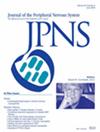Longitudinal follow-up and prognostic factors in nitrous oxide-induced neuropathy
Abstract
Background and Aim
Recreational use of nitrous oxide (N2O) has been associated with the development of severe nitrous oxide-induced neuropathy (N2On). Follow-up of these patients poses challenges, and their clinical progression remains largely unknown. The identification of prognostic factors is made difficult by the lack of standardized longitudinal assessments in most studies. The objective was to document the course of neuropathy through systematic follow-up assessments in N2On patients to identify prognostic factors for persistent disability after 6 months.
Methods
We gathered demographic, clinical, biological, and electrophysiological data from N2On patients hospitalized in the Referral center in Marseille, both at baseline and during a standardized follow-up assessment at 6 months.
Results
We retrospectively included 26 N2On patients (mean age 22.6 ± 4.4). Significant improvements were observed in all main clinical scores including Rankin, ONLS, and MRC testing (p < .01). Electrophysiological studies (EDX) revealed a predominantly motor neuropathy with marked reduction in CMAP in the lower limbs at baseline, and no significant improvement in motor parameters (p = .543). Rankin score at 6 months correlated with the initial weekly N2O consumption (r = .43, p = .03) and the CMAP sum score in the lower limbs at the first EDX (r = −.47, p = .02). Patients with and without myelitis showed similar Rankin and ONLS score after 6 months.
Interpretation
The clinical course generally improved favorably at 6 months with notable amelioration in the primary disability scores, sensory deficits, and ataxia. However, distal motor impairment associated with peripheral neuropathy persisted, with distal axonal loss emerging as the main prognostic factor for long-term disability in these young patients.

 求助内容:
求助内容: 应助结果提醒方式:
应助结果提醒方式:


